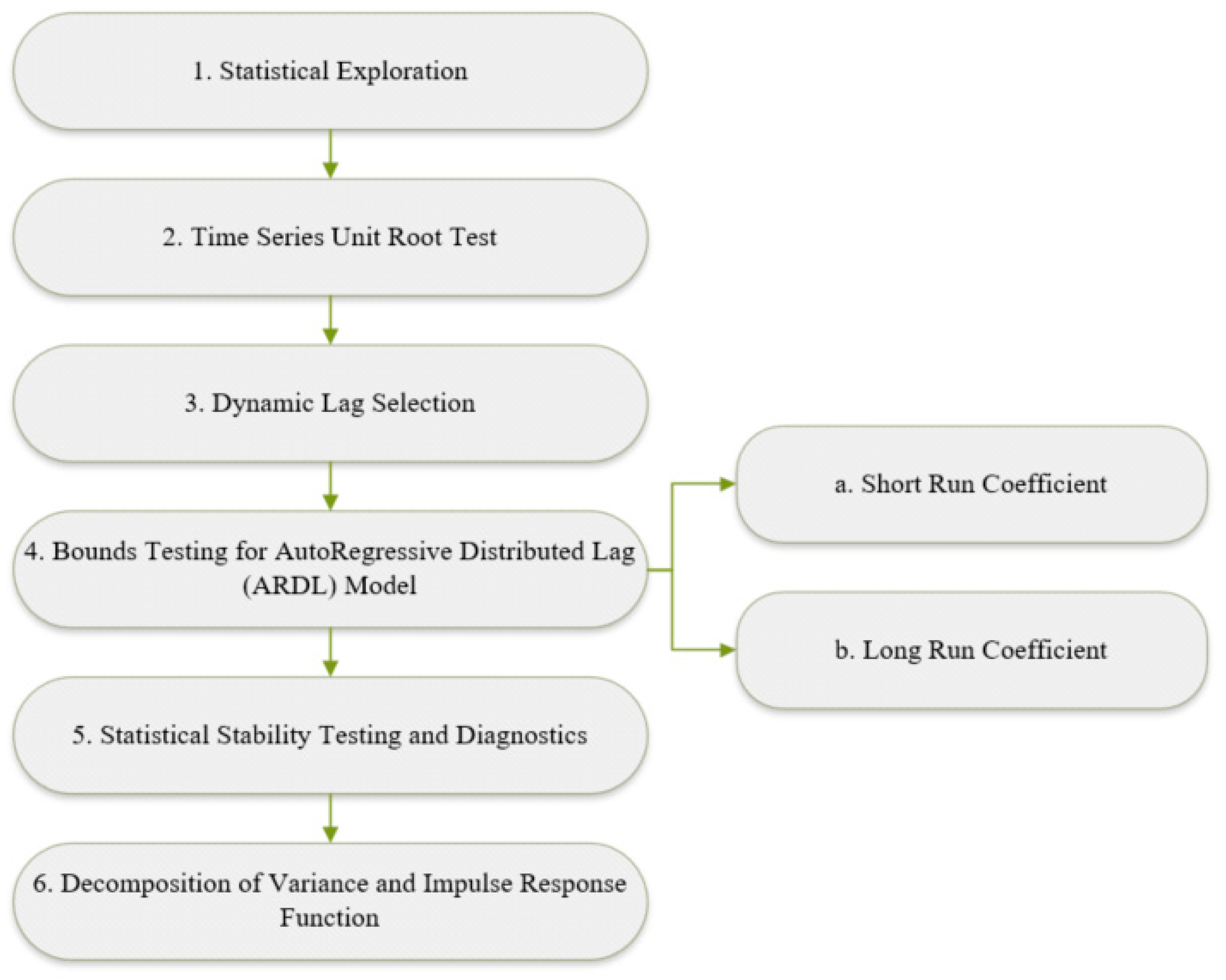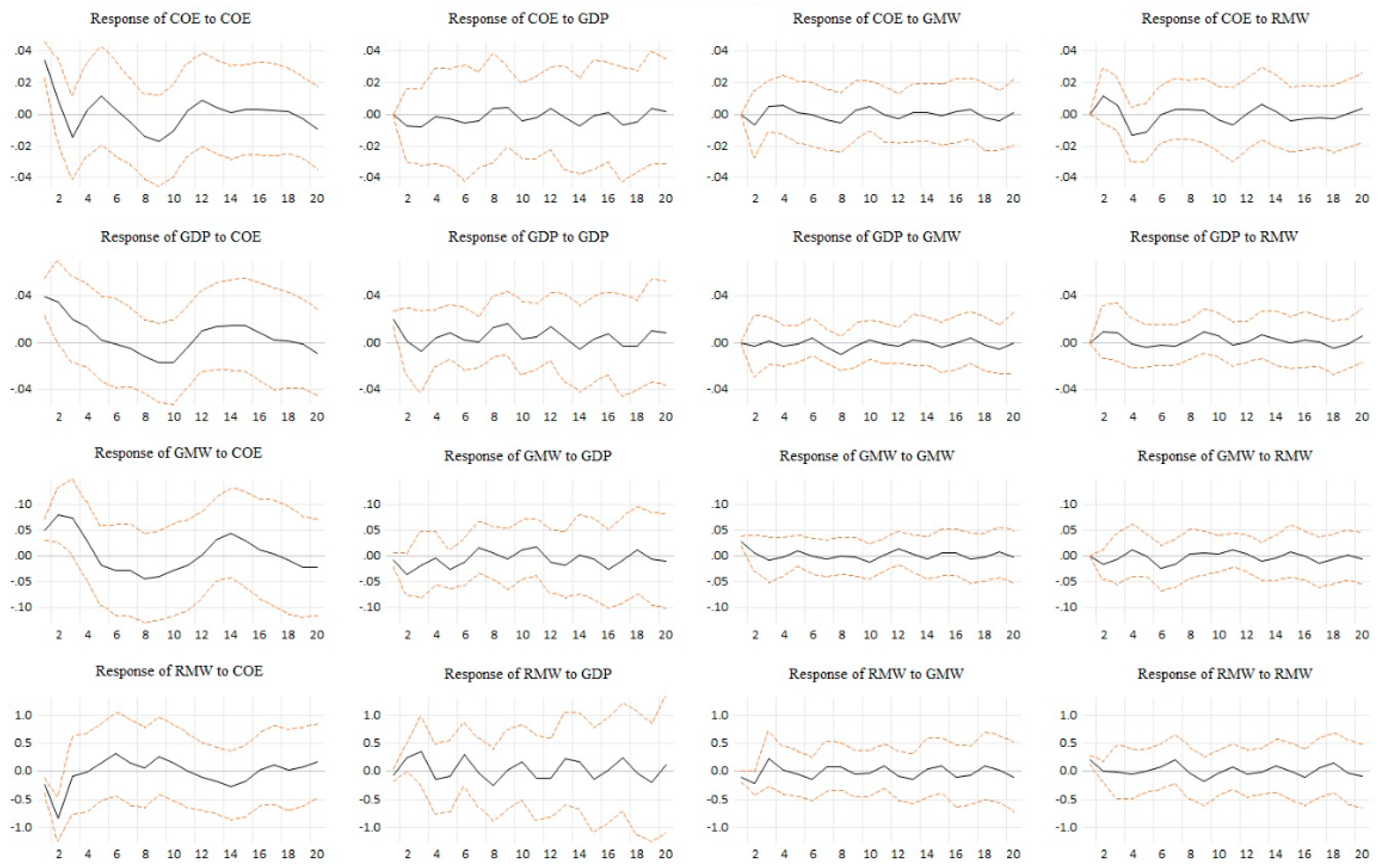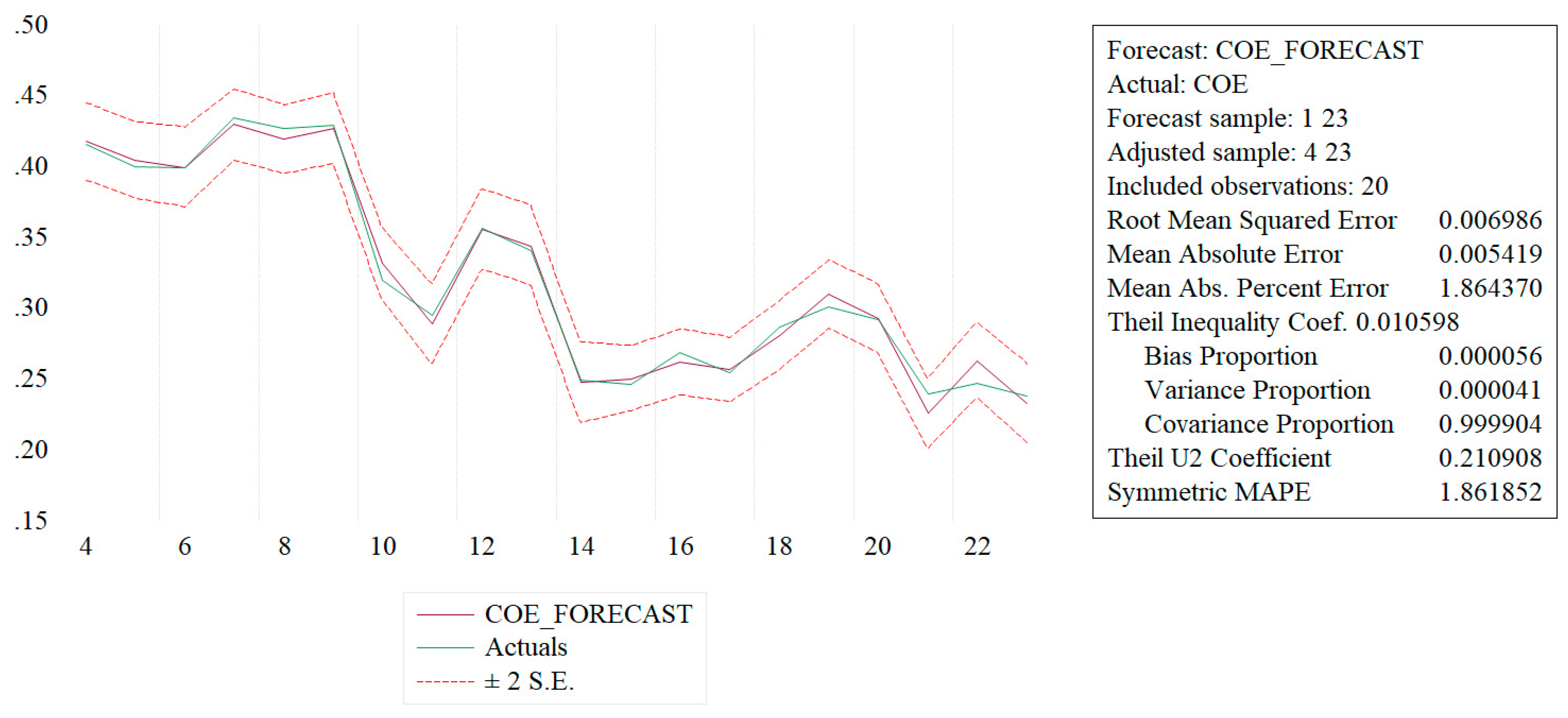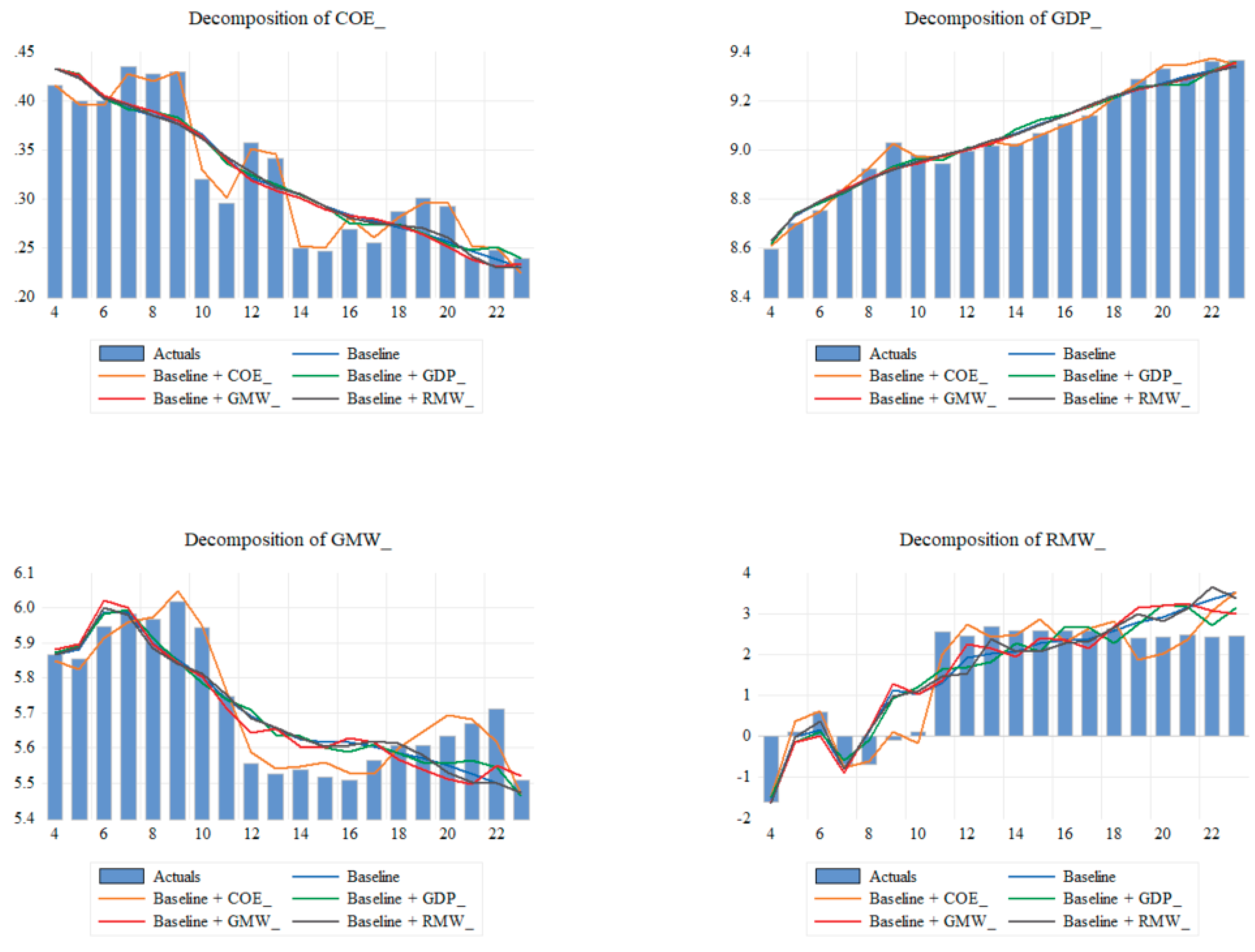A Cybernetics Approach and Autoregressive Distributed Lag Econometric Exploration of Romania’s Circular Economy
Abstract
:1. Introduction
- Resources are used in a closed-loop system, where they undergo reuse and recycling, reducing the need for new resources and mitigating environmental consequences;
- Products are designed to have longer lifespans through maintenance, repair, and reuse;
- Materials from used products are extracted and reprocessed to create new products, reducing the demand for raw material.
- i.
- Integration of CE and Cybernetic Systems: The study effectively integrates CE principles into a cybernetics system, improving strategic decision making through the use of the ARDL technique;
- ii.
- Analysis of Dynamic Interdependence: The study explores the dynamic interdependence between emissions and CE factors, highlighting feedback loops and control mechanisms within CE strategies;
- iii.
- Decoupling Economic Growth from COE: The study identifies a long-term negative relationship between economic growth and COE, indicating a decoupling process with significant implications for sustainable development;
- iv.
- Focus on the Romanian Context: Our research provides an innovative contribution to Romanian CE literature, providing valuable insights for public policy and sustainable practices.
2. Theoretical Background
2.1. The Stage of Knowledge in the Field
2.1.1. The Relationship between CE and COE
2.1.2. Literature Review on CE in Romania
2.1.3. The Use of the ARDL Model in CE Analysis
2.2. A Cybernetics Approach to the CE System
3. ARDL Econometric Methodology
4. Data Collection and Results
5. Discussion
6. Conclusions and Policy Recommendations
Author Contributions
Funding
Institutional Review Board Statement
Informed Consent Statement
Data Availability Statement
Acknowledgments
Conflicts of Interest
Abbreviations
| Acronym | Definition |
| CE | Circular Economy |
| COE | CO2 emissions |
| GHGs | Greenhouse gases |
| MSW | Municipal solid waste |
| GDP | Gross Domestic Product |
| GMW | Generation of municipal waste per capita |
| RMW | Recycling rate of municipal waste |
| CAS | Complex Adaptive Systems |
| ECM | Error Correction Model |
| CUSUM | Cumulative sum |
| IFRs | Impulse response functions |
| EKC | Environmental Kuznets Curve |
| VD | Variance Decomposition |
| AIC | Akaike Information Criterion |
| ADF | Augmented Dickey–Fuller |
| FPE | Final prediction error |
| SC | Schwarz information criterion |
| HQ | Hannan–Quinn information criterion |
| SCR | Serial Correlation |
| HE | Heteroscedasticity |
| NO | Normal distribution |
| RR | Ramsey RESET test |
References
- Hailemariam, A.; Erdiaw-Kwasie, M.O. Towards a Circular Economy: Implications for Emission Reduction and Environmental Sustainability. Bus. Strategy Environ. 2023, 32, 1951–1965. [Google Scholar] [CrossRef]
- Rădulescu, C.V.; Bran, F.; Ciuvăț, A.L.; Bodislav, D.A.; Buzoianu, O.C.; Ștefănescu, M.; Burlacu, S. Decoupling the Economic Development from Resource Consumption: Implications and Challenges in Assessing the Evolution of Forest Area in Romania. Land 2022, 11, 1097. [Google Scholar] [CrossRef]
- Tiwari, S.; Si Mohammed, K.; Mentel, G.; Majewski, S.; Shahzadi, I. Role of Circular Economy, Energy Transition, Environmental Policy Stringency, and Supply Chain Pressure on CO2 Emissions in Emerging Economies. Geosci. Front. 2023, 15, 101682. [Google Scholar] [CrossRef]
- Deutz, P. Circular Economy. In International Encyclopedia of Human Geography; Elsevier: Amsterdam, The Netherlands, 2020; pp. 193–201. ISBN 978-0-08-102296-2. [Google Scholar]
- European Environment Agency. Available online: https://circulareconomy.europa.eu/platform/sites/default/files/circular_by_design_-_products_in_the_circular_economy.pdf (accessed on 9 March 2024).
- Magazzino, C.; Mele, M.; Schneider, N.; Sarkodie, S.A. Waste Generation, Wealth and GHG Emissions from the Waste Sector: Is Denmark on the Path towards Circular Economy? Sci. Total Environ. 2021, 755, 142510. [Google Scholar] [CrossRef]
- European Parliament Circular Economy: Definition, Importance and Benefits. Available online: https://www.europarl.europa.eu/topics/en/article/20151201STO05603/circular-economy-definition-importance-and-benefits (accessed on 8 April 2024).
- European Commission the European Green Deal. Available online: https://commission.europa.eu/strategy-and-policy/priorities-2019-2024/european-green-deal_en (accessed on 9 June 2024).
- European Commission Circular Economy Action Plan. Available online: https://environment.ec.europa.eu/strategy/circular-economy-action-plan_en (accessed on 9 August 2024).
- Piciu, G.C. The Role of Circular Economy in Mitigating Greenhouse Gas Emission. In Reimagining Capitalism in a Post-Globalization World; Fotea, S.L., Văduva, S.A., Fotea, I.Ş., Eds.; Springer Proceedings in Business and Economics; Springer Nature Switzerland: Cham, Switzerland, 2024; pp. 251–264. ISBN 978-3-031-59857-9. [Google Scholar]
- Mocanu, A.A.; Brătucu, G.; Ciobanu, E.; Chițu, I.B.; Szakal, A.C. Can the Circular Economy Unlock Sustainable Business Growth? Insights from Qualitative Research with Specialists in Romania. Sustainability 2024, 16, 2031. [Google Scholar] [CrossRef]
- Chiriță, N.; Georgescu, I. Cybernetics Analysis of the Circular Economy from Romania. In Proceedings of the 22nd International Conference on Informatics in Economy (IE 2023), Bucharest, Romania, 25–26 May 2023; Ciurea, C., Pocatilu, P., Filip, F.G., Eds.; Smart Innovation, Systems and Technologies. Springer Nature Singapore: Singapore, 2024; Volume 367, pp. 319–330, ISBN 978-981-9969-59-3. [Google Scholar]
- Magazzino, C.; Mele, M.; Schneider, N. The Relationship between Municipal Solid Waste and Greenhouse Gas Emissions: Evidence from Switzerland. Waste Manag. 2020, 113, 508–520. [Google Scholar] [CrossRef] [PubMed]
- Georgescu, I.; Kinnunen, J.; Androniceanu, A.-M. Empirical evidence on circular economy and economic development in Europe: A panel approach. J. Bus. Econ. Manag. 2022, 23, 199–217. [Google Scholar] [CrossRef]
- Bâra, A.; Oprea, S.-V.; Oprea, N. How Fast to Avoid Carbon Emissions: A Holistic View on the RES, Storage and Non-RES Replacement in Romania. Int. J. Environ. Res. Public Health 2023, 20, 5115. [Google Scholar] [CrossRef]
- Bucur, C.; Tudorica, B.G.; Oprea, S.-V.; Nancu, D.; Dusmanescu, D.M. Insights Into Energy Indicators Analytics Towards European Green Energy Transition Using Statistics and Self-Organizing Maps. IEEE Access 2021, 9, 64427–64444. [Google Scholar] [CrossRef]
- Bâra, A.; Oprea, S.-V.; Georgescu, I.A. Understanding electricity price evolution—Day-ahead market competitiveness in Romania. J. Bus. Econ. Manag. 2023, 24, 221–244. [Google Scholar] [CrossRef]
- Schwarz, A.E.; Ligthart, T.N.; Godoi Bizarro, D.; De Wild, P.; Vreugdenhil, B.; Van Harmelen, T. Plastic Recycling in a Circular Economy; Determining Environmental Performance through an LCA Matrix Model Approach. Waste Manag. 2021, 121, 331–342. [Google Scholar] [CrossRef] [PubMed]
- Razzaq, A.; Sharif, A.; Najmi, A.; Tseng, M.-L.; Lim, M.K. Dynamic and Causality Interrelationships from Municipal Solid Waste Recycling to Economic Growth, Carbon Emissions and Energy Efficiency Using a Novel Bootstrapping Autoregressive Distributed Lag. Resour. Conserv. Recycl. 2021, 166, 105372. [Google Scholar] [CrossRef]
- Tcvetkov, P.; Cherepovitsyn, A.; Fedoseev, S. The Changing Role of CO2 in the Transition to a Circular Economy: Review of Carbon Sequestration Projects. Sustainability 2019, 11, 5834. [Google Scholar] [CrossRef]
- Gallego-Schmid, A.; Chen, H.-M.; Sharmina, M.; Mendoza, J.M.F. Links between Circular Economy and Climate Change Mitigation in the Built Environment. J. Clean. Prod. 2020, 260, 121115. [Google Scholar] [CrossRef]
- Bayar, Y.; Gavriletea, M.D.; Sauer, S.; Paun, D. Impact of Municipal Waste Recycling and Renewable Energy Consumption on CO2 Emissions across the European Union (EU) Member Countries. Sustainability 2021, 13, 656. [Google Scholar] [CrossRef]
- Vermeșan, H.; Mangău, A.; Tiuc, A.-E. Perspectives of Circular Economy in Romanian Space. Sustainability 2020, 12, 6819. [Google Scholar] [CrossRef]
- Topliceanu, L.; Puiu, P.G.; Drob, C.; Topliceanu, V.V. Analysis Regarding the Implementation of the Circular Economy in Romania. Sustainability 2022, 15, 333. [Google Scholar] [CrossRef]
- Dobre-Baron, O.; Nițescu, A.; Niță, D.; Mitran, C. Romania’s Perspectives on the Transition to the Circular Economy in an EU Context. Sustainability 2022, 14, 5324. [Google Scholar] [CrossRef]
- Botezat, E.; Dodescu, A.; Văduva, S.; Fotea, S. An Exploration of Circular Economy Practices and Performance among Romanian Producers. Sustainability 2018, 10, 3191. [Google Scholar] [CrossRef]
- Nica, I.; Chiriță, N.; Delcea, C. Towards a Sustainable Future: Economic Cybernetics in Analyzing Romania’s Circular Economy. Sustainability 2023, 15, 14433. [Google Scholar] [CrossRef]
- Potârniche, M.E.; Giucă, A.D.; Stoica, G.D.; Sterie, C.M. The Circular Economy in Romania and in the EU Member States. Proc. Int. Conf. Bus. Excell. 2022, 16, 409–419. [Google Scholar] [CrossRef]
- Burlacu, S.; Bran, F.; Rădulescu, C.V.; Bodislav, D.A. The Circular Economy—Romania’s Paradigm from the Perspective of EU Principles and Directions for 2050. Proc. Int. Conf. Bus. Excell. 2022, 16, 278–284. [Google Scholar] [CrossRef]
- Barna, C.; Zbuchea, A.; Stănescu, S.M. Social Economy Enterprises Contributing to the Circular Economy and the Green Transition in Romania. Ciriec-España 2023, 107, 47–69. [Google Scholar] [CrossRef]
- Lacko, R.; Hajduová, Z.; Dula, R. Development of Environmental Performance and Circular Economy in the European Union Countries: The Case of “Post-2004” Members. Front. Environ. Sci. 2024, 12, 1467370. [Google Scholar] [CrossRef]
- Musa, K.; Tufail, S.; Erum, N.; Said, J.; Mustaffa, A.H. Impact of the Circular Economy on Ecological Footprint: Evidence from Germany. Environ. Sci. Pollut. Res. 2024. [Google Scholar] [CrossRef]
- Erdiaw-Kwasie, M.O.; Owusu-Ansah, K.K.; Abunyewah, M.; Alam, K.; Hailemariam, A.; Arhin, P.; Zander, K.K.; Lassa, J. Circular Economy, Environmental Quality and Tourism Receipts in Europe: A Time Series Data Analysis. PLoS ONE 2023, 18, e0288098. [Google Scholar] [CrossRef]
- Sasmoko; Zaman, K.; Malik, M.; Awan, U.; Handayani, W.; Jabor, M.K.; Asif, M. Environmental Effects of Bio-Waste Recycling on Industrial Circular Economy and Eco-Sustainability. Recycling 2022, 7, 60. [Google Scholar] [CrossRef]
- Nica, I.; Chirita, N. Holistic Approach of Complex Adaptive Systems. Theory, Applications and Case Studies; LAP Lambert Academic Publishing: Saarbrucken, Germany, 2021; ISBN 978-620-3-30709-2. [Google Scholar]
- Korhonen, J. The Circular Economy as a Complex Adaptive System. In Handbook of the Circular Economy; Brandão, M., Lazarevic, D., Finnveden, G., Eds.; Edward Elgar Publishing: Cheltenham, UK, 2020; ISBN 978-1-78897-272-7. [Google Scholar]
- Guzzo, D.; Pigosso, D.C.A.; Videira, N.; Mascarenhas, J. A System Dynamics-Based Framework for Examining Circular Economy Transitions. J. Clean. Prod. 2022, 333, 129933. [Google Scholar] [CrossRef]
- Rios, F.C.; Panic, S.; Grau, D.; Khanna, V.; Zapitelli, J.; Bilec, M. Exploring Circular Economies in the Built Environment from a Complex Systems Perspective: A Systematic Review and Conceptual Model at the City Scale. Sustain. Cities Soc. 2022, 80, 103411. [Google Scholar] [CrossRef]
- Wiener, N. Cybernetics or Control and Communication in the Animal and the Machine; The MIT Press: Cambridge, MA, USA, 2019; ISBN 978-0-262-35590-2. [Google Scholar]
- Herbert, S. The Architecture of Complexity. Proc. Am. Philos. Soc. 1962, 106, 467–482. [Google Scholar]
- Awewomom, J.; Dzeble, F.; Takyi, Y.D.; Ashie, W.B.; Ettey, E.N.Y.O.; Afua, P.E.; Sackey, L.N.A.; Opoku, F.; Akoto, O. Addressing Global Environmental Pollution Using Environmental Control Techniques: A Focus on Environmental Policy and Preventive Environmental Management. Discov. Environ. 2024, 2, 8. [Google Scholar] [CrossRef]
- Pesaran, M.H.; Shin, Y. An Autoregressive Distributed-Lag Modelling Approach to Cointegration Analysis. In Econometrics and Economic Theory in the 20th Century: The Ragnar Frisch Centennial Symposium; Strøm, S., Ed.; Cambridge University Press: New York, NY, USA, 1998; pp. 371–413. ISBN 978-0-521-63323-9. [Google Scholar]
- Pesaran, M.H.; Shin, Y.; Smith, R.J. Bounds Testing Approaches to the Analysis of Level Relationships. J. Appl. Econom. 2001, 16, 289–326. [Google Scholar] [CrossRef]
- Nkoro, E.; Uko, A.K. Autoregressive Distributed Lag (ARDL) Cointegration Technique: Application and Interpretation. J. Stat. Econom. Methods 2016, 5, 63–91. [Google Scholar]
- Portet, S. A Primer on Model Selection Using the Akaike Information Criterion. Infect. Dis. Model. 2020, 5, 111–128. [Google Scholar] [CrossRef] [PubMed]
- Grossman, G.; Krueger, A. Environmental Impacts of a North American Free Trade Agreement; National Bureau of Economic Research: Cambridge, MA, USA, 1991; p. w3914. [Google Scholar]
- Ayodele, B.V.; Mustapa, S.I.; Alsaffar, M.A.; Vo, D.-V.N. Sustainable Utilization of CO2 toward a Circular Economy: Prospects, Challenges, and Opportunities. In Carbon Dioxide Capture and Conversion; Elsevier: Amsterdam, The Netherlands, 2022; pp. 17–36. ISBN 978-0-323-85585-3. [Google Scholar]
- Narayan, P.K.; Smyth, R. What determines migration flows from low-income to high-income countries? An empirical investigation of Fiji–U.S. migration 1972–2001. Contemp. Econ. Policy 2006, 24, 332–342. [Google Scholar] [CrossRef]
- Brown, R.L.; Durbin, J.; Evans, J.M. Techniques for Testing the Constancy of Regression Relationships Over Time. J. R. Stat. Soc. Ser. B Stat. Methodol. 1975, 37, 149–163. [Google Scholar] [CrossRef]
- Unegg, M.C.; Steininger, K.W.; Ramsauer, C.; Rivera-Aguilar, M. Assessing the Environmental Impact of Waste Management: A Comparative Study of CO2 Emissions with a Focus on Recycling and Incineration. J. Clean. Prod. 2023, 415, 137745. [Google Scholar] [CrossRef]
- Cudjoe, D.; Wang, H.; Zhu, B. Assessment of the Potential Energy and Environmental Benefits of Solid Waste Recycling in China. J. Environ. Manag. 2021, 295, 113072. [Google Scholar] [CrossRef]
- Meys, R.; Frick, F.; Westhues, S.; Sternberg, A.; Klankermayer, J.; Bardow, A. Towards a Circular Economy for Plastic Packaging Wastes—The Environmental Potential of Chemical Recycling. Resour. Conserv. Recycl. 2020, 162, 105010. [Google Scholar] [CrossRef]
- Androniceanu, A.; Georgescu, I.; Nica, I.; Chiriță, N. A Comprehensive Analysis of Renewable Energy Based on Integrating Economic Cybernetics and the Autoregressive Distributed Lag Model—The Case of Romania. Energies 2023, 16, 5978. [Google Scholar] [CrossRef]
- Georgescu, I.; Kinnunen, J. The Role of Foreign Direct Investments, Urbanization, Productivity, and Energy Consumption in Finland’s Carbon Emissions: An ARDL Approach. Environ. Sci. Pollut. Res. 2023, 30, 87685–87694. [Google Scholar] [CrossRef]
- Georgescu, I.; Kinnunen, J.; Nica, I. Assessing Forest Conservation for Finland: An ARDL-Based Evaluation. Sustainability 2024, 16, 612. [Google Scholar] [CrossRef]
- Blagoeva, N.; Georgieva, V.; Dimova, D. Relationship between GDP and Municipal Waste: Regional Disparities and Implication for Waste Management Policies. Sustainability 2023, 15, 15193. [Google Scholar] [CrossRef]
- Binsuwadan, J.; Yousif, G.; Abdulrahim, H.; Alofaysan, H. The Role of the Circular Economy in Fostering Sustainable Economic Growth in the GCC. Sustainability 2023, 15, 15926. [Google Scholar] [CrossRef]
- Too, H.K.; Bett, H.K.; Gitau, R. What Explains the Trends of Wheat Imports in Kenya; A Cointegration Analysis Using ARDL-ECM Modelling. J. Econ. Sustain. Dev. 2021, 12, 6–98. [Google Scholar] [CrossRef]
- Wolde-Rufael, Y. The defence spending–external debt nexus in Ethiopia. Def. Peace Econ. 2009, 20, 423–436. [Google Scholar] [CrossRef]
- Sims, C.A. Macroeconomics and Reality. Econometrica 1980, 48, 1–48. [Google Scholar] [CrossRef]
- Osinsky, A.; Bychkov, R.; Trefilov, M.; Lyashev, V.; Ivanov, A. Regularization for Cholesky Decomposition in Massive MIMO Detection. IEEE Wirel. Commun. Lett. 2023, 12, 1603–1607. [Google Scholar] [CrossRef]
- European Union National Strategy for the Circular Economy in Romania. Available online: https://circulareconomy.europa.eu/platform/en/strategies/national-strategy-circular-economy-romania (accessed on 18 December 2023).
- Chang, Z.; Jiao, Y.; Wang, X. Influencing the Variable Selection and Prediction of Carbon Emissions in China. Sustainability 2023, 15, 13848. [Google Scholar] [CrossRef]
- Kirchherr, J.; Yang, N.-H.N.; Schulze-Spüntrup, F.; Heerink, M.J.; Hartley, K. Conceptualizing the Circular Economy (Revisited): An Analysis of 221 Definitions. Resour. Conserv. Recycl. 2023, 194, 107001. [Google Scholar] [CrossRef]









| Variable | Acronym | Measurement Unit | Source |
|---|---|---|---|
| Annual CO2 emissions (per capita) | COE | Metric tons per capita | World Bank |
| Real GDP per capita | GDP | Constant 2015 USD | World Bank |
| Generation of municipal waste per capita | GMW | Kilograms per capita | Eurostat |
| Recycling rate of municipal waste | RMW | % | Eurostat |
| COE | GDP | GMW | RMW | |
|---|---|---|---|---|
| Mean | 1.389858 | 8195.056 | 314.8521 | 7.543478 |
| Median | 1.376789 | 8234.305 | 302 | 11.3 |
| Maximum | 1.543978 | 11,670.14 | 411 | 14.8 |
| Minimum | 1.269127 | 4567.24 | 246.5974 | 0 |
| Std. Dev. | 0.096388 | 2178.584 | 57.82317 | 5.971510 |
| Skewness | 0.267241 | 0.022256 | 0.251110 | −0.127223 |
| Kurtosis | 1.625616 | 2.010925 | 1.499370 | 1.152229 |
| Jarque–Bera | 2.083994 | 0.939408 | 2.399779 | 3.492877 |
| Probability | 0.352750 | 0.625187 | 0.301227 | 0.177917 |
| Variables | Level | First Difference | Order of Integration |
|---|---|---|---|
| T-Statistics | T-Statistics | ||
| COE | 1.07 (0.705) | 4.39 *** (0.002) | I (1) |
| GDP | 1.91 (0.320) | 3.82 *** (0.009) | I (1) |
| GMW | 1.05 (0.713) | 2.88 * (0.063) | I (1) |
| RMW | 1.44 (0.539) | 5.46 *** (0.000) | I (1) |
| Lag | LogL | LR | FPE | AIC | SC | HQ |
|---|---|---|---|---|---|---|
| 0 | 39.91 | NA | 3.78 | 3.58 | 3.74 | |
| 1 | 105.12 | 96.09 | 8.96 | 7.96 | 8.79 | |
| 2 | 144.06 | 40.99 * | 11.37 | 9.58 | 11.07 | |
| 3 | 170.97 | 16.99 | 12.52 * | 9.93 * | 12.08 * |
| Test Statistic | Value | K (Number of Regressors) |
|---|---|---|
| F-statistic | 17.88 | 3 |
| Critical value bounds (Finite sample n = 30) | ||
| Significance | I (0) | I (1) |
| 10% | 2.67 | 3.59 |
| 5% | 3.27 | 4.30 |
| 1% | 4.61 | 5.96 |
| Variables | Coefficient | T-Statistics | Prob. |
|---|---|---|---|
| GDP | 0.18 | 5.14 | 0.000 *** |
| GMW | 0.57 | 5.72 | 0.000 *** |
| RMW | 0.06 | 3.50 | 0.008 *** |
| C | 1.45 | 4.06 | 0.003 *** |
| Variable | Coefficient | T-Statistics | Prob. |
|---|---|---|---|
| D (GDP) | 0.57 | 13.25 | 0.000 *** |
| D (GDP (−1)) | 0.78 | 7.25 | 0.000 *** |
| D (GDP (−2)) | 0.24 | 3.58 | 0.007 *** |
| D (GMW) | 0.22 | 6.57 | 0.000 *** |
| D (GMW (−1)) | 0.49 | 7.39 | 0.000 *** |
| D (RMW) | 0.01 | 3.48 | 0.008 *** |
| D (RMW (−1)) | 0.02 | -0.55 | 0.000 *** |
| CointEq (−1) | 1.21 | 11.58 | 0.000 *** |
| R-squared | 0.97 | ||
| Adjusted R-squared | 0.95 | ||
| Test | H0 | Decision Statistics [p-Value] |
|---|---|---|
| SC * | There is no serial correlation in the residuals | Accept H0 2.00 [0.214] |
| HE ** | There is no autoregressive conditional heteroscedasticity | Accept H0 0.25 [0.622] |
| NO *** | Normal distribution | Accept H0 0.05 [0.971] |
| RR **** | Absence of model misspecification | Accept H0 3.14 [0.116] |
| Variable | Period | COE | GDP | GMW | RMW |
|---|---|---|---|---|---|
| COE | 1 | 100.00 | 0.00 | 0.00 | 0.00 |
| 5 | 70.03 | 5.14 | 4.37 | 20.44 | |
| 10 | 71.47 | 6.62 | 5.56 | 16.32 | |
| 15 | 68.57 | 8.29 | 5.33 | 17.78 | |
| 20 | 66.74 | 9.89 | 5.96 | 17.38 | |
| GDP | 1 | 79.55 | 20.44 | 0.00 | 0.00 |
| 5 | 81.87 | 13.43 | 0.55 | 4.13 | |
| 10 | 73.34 | 18.12 | 2.89 | 5.63 | |
| 15 | 72.48 | 18.99 | 2.92 | 5.59 | |
| 20 | 69.53 | 20.89 | 3.50 | 6.06 | |
| GMW | 1 | 74.51 | 1.66 | 23.82 | 0.00 |
| 5 | 80.62 | 11.90 | 5.17 | 2.29 | |
| 10 | 79.65 | 10.96 | 4.42 | 4.95 | |
| 15 | 78.80 | 11.47 | 4.60 | 5.10 | |
| 20 | 76.46 | 13.47 | 4.60 | 5.45 | |
| RMW | 1 | 47.66 | 4.04 | 8.10 | 40.18 |
| 5 | 67.97 | 18.37 | 9.55 | 4.09 | |
| 10 | 58.89 | 23.30 | 8.84 | 7.95 | |
| 15 | 56.73 | 25.96 | 9.72 | 7.56 | |
| 20 | 52.80 | 28.14 | 10.12 | 8.92 |
Disclaimer/Publisher’s Note: The statements, opinions and data contained in all publications are solely those of the individual author(s) and contributor(s) and not of MDPI and/or the editor(s). MDPI and/or the editor(s) disclaim responsibility for any injury to people or property resulting from any ideas, methods, instructions or products referred to in the content. |
© 2024 by the authors. Licensee MDPI, Basel, Switzerland. This article is an open access article distributed under the terms and conditions of the Creative Commons Attribution (CC BY) license (https://creativecommons.org/licenses/by/4.0/).
Share and Cite
Georgescu, I.; Nica, I.; Delcea, C.; Ciurea, C.; Chiriță, N. A Cybernetics Approach and Autoregressive Distributed Lag Econometric Exploration of Romania’s Circular Economy. Sustainability 2024, 16, 8248. https://doi.org/10.3390/su16188248
Georgescu I, Nica I, Delcea C, Ciurea C, Chiriță N. A Cybernetics Approach and Autoregressive Distributed Lag Econometric Exploration of Romania’s Circular Economy. Sustainability. 2024; 16(18):8248. https://doi.org/10.3390/su16188248
Chicago/Turabian StyleGeorgescu, Irina, Ionuț Nica, Camelia Delcea, Cristian Ciurea, and Nora Chiriță. 2024. "A Cybernetics Approach and Autoregressive Distributed Lag Econometric Exploration of Romania’s Circular Economy" Sustainability 16, no. 18: 8248. https://doi.org/10.3390/su16188248










